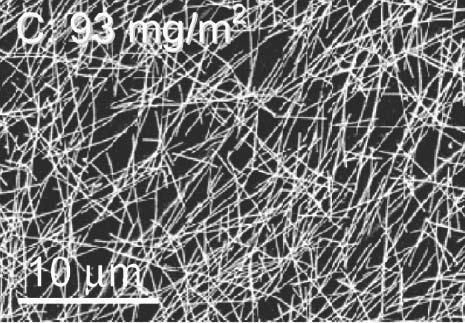New Options for transparent contact electrodes

Scanning Electron Microscopy of Nanowires of Silver.
They have diameters around 0,1 micrometer and lenghts
between 5 and 10 micrometern. © ACS Nano 3: 1767-1774
Found in flat screens, solar modules, or in new organic light-emitting diode (LED) displays, transparent electrodes have become ubiquitous. Typically, they consist of metal oxides like In2O3, SnO2, ZnO and TiO2 .
But since raw materials like indium are becoming more and more costly, researchers have begun to look elsewhere for alternatives. A new review article by HZB scientist Dr. Klaus Ellmer, published in the renowned scientific journal Nature Photonics, is hoping to shed light on the different advantages and disadvantages of established and new materials for use in these kinds of contact electrodes.
Metallic (Ag or Cu) or carbon based nanostructures exhibit many interesting properties that could potentially be exploited pending further research.Even graphene, a modified form of carbon, could turn out to be a suitable transparent electrode, since it is both transparent and highly conductive. These properties depend, to a large extent, on the material's composition:graphene, which consists of a single layer of carbon atoms arranged into a hexagonal "honeycomb" grid, is two-dimensional, and, within these dimensions, electrons can freely move about.
According to Ellmer, "these new kinds of materials could be combined with more conventional solutions or find their way into entirely new areas of application." For this to become a reality, researchers have yet to come up with solutions to nanostructure problems like short circuits and continue to illuminate the relevant transport mechanisms. It would also be interesting to determine whether these two-dimensional "electron gases" also form in materials other than graphene. Success ultimately depends on whether or not the new materials prove stable in the long run in their practical application and whether or not they can be produced relatively inexpensively.
Ellmer is sole author of an extensive review article published in Nature photonics online on 30. November 2012, doi: 10.1038/nphoton.2012.282
https://www.helmholtz-berlin.de/pubbin/news_seite?nid=13660;sprache=en
- Copy link
-
Lithium-sulphur batteries with lean electrolyte: problem areas clarified
Using a non-destructive method, a team at HZB investigated practical lithium-sulphur pouch cells with lean electrolyte for the first time. With operando neutron tomography, they could visualise in real-time how the liquid electrolyte distributes and wets the electrodes across multilayers during charging and discharging. These findings offer valuable insights into the cell failure mechanisms and are helpful to design compact Li-S batteries with a high energy density in formats relevant to industrial applications.
-
Berlin Science Award goes to Philipp Adelhelm
Battery researcher Prof. Dr. Philipp Adelhelm has been awarded the 2024 Berlin Science Award. He is a professor at the Institute of Chemistry at Humboldt University in Berlin (HU) and heads a joint research group at HU and the Helmholtz Zentrum Berlin (HZB). The materials scientist and electrochemist is investigating sustainable batteries, which play a key role in the success of the energy transition. He is one of the leading international experts in the field of sodium-ion batteries.
-
Sodium-ion batteries: New storage mechanism for cathode materials
Li-ion and Na-ion batteries operate through a process called intercalation, where ions are stored and exchanged between two chemically different electrodes. In contrast, co-intercalation, a process in which both ions and solvent molecules are stored simultaneously, has traditionally been considered undesirable due to its tendency to cause rapid battery failure. Against this traditional view, an international research team led by Philipp Adelhelm has now demonstrated that co-intercalation can be a reversible and fast process for cathode materials in Na-ion batteries. The approach of jointly storing ions and solvents in cathode materials provides a new handle for designing batteries with high efficiency and fast charging capabilities. The results are published in Nature Materials.
